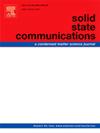First-principles study on the electronic structure and photocatalytic properties of transition metal(Fe,Co,Ni) and N co-doped graphene-like ZnO monolayer
IF 2.4
4区 物理与天体物理
Q3 PHYSICS, CONDENSED MATTER
引用次数: 0
Abstract
We have systematically investigated the electronic structure, magnetic properties, and photocatalytic properties of transition metal(TM = Fe, Co, Ni) and N codoped ZnO monolayer using density functional theory(DFT). All co-doping ZnO monolayer systems exhibit ferromagnetism. The magnetic moment of the co-doping systems mainly comes from the d orbital of the TM elements and the d-p orbital hybridization between the TM elements and the surrounding non-metal atom. The work functions have been further reduced by TM(Fe, Co, Ni) doping. The band edge positions ECBM and EVBM are all higher and lower than the oxidation-reduction potential of water at both pH = 0 and pH = 7, respectively. The absorption spectra have a red shift by TM(Fe, Co, Ni) mono- and co-doped. The ECBM and EVBM of Co mono-doped and Co/N codoped systems are closer to the standard redox potentials, which is expected to further improve the catalytic efficiency of the material for water splitting. The results demonstrate that the doped ZnO monolayer system is a promising spin electron device and photocatalytic catalyst for water splitting.
过渡金属(Fe,Co,Ni)和N共掺杂类石墨烯ZnO单层的电子结构和光催化性能第一性原理研究
利用密度泛函理论(DFT)系统地研究了过渡金属(TM = Fe, Co, Ni)和N共掺杂ZnO单层的电子结构、磁性和光催化性能。所有共掺杂ZnO单层体系都表现出铁磁性。共掺杂体系的磁矩主要来源于TM元素的d轨道和TM元素与周围非金属原子之间的d-p轨道杂化。TM(Fe, Co, Ni)的掺杂进一步降低了其功函数。在pH = 0和pH = 7时,ECBM和EVBM的能带边缘位置均高于和低于水的氧化还原电位。TM(Fe, Co, Ni)单掺杂和共掺杂使吸收光谱发生红移。Co单掺杂和Co/N共掺杂体系的ECBM和EVBM更接近标准氧化还原电位,有望进一步提高材料对水裂解的催化效率。结果表明,掺杂ZnO单层体系是一种很有前途的自旋电子器件和水裂解光催化催化剂。
本文章由计算机程序翻译,如有差异,请以英文原文为准。
求助全文
约1分钟内获得全文
求助全文
来源期刊

Solid State Communications
物理-物理:凝聚态物理
CiteScore
3.40
自引率
4.80%
发文量
287
审稿时长
51 days
期刊介绍:
Solid State Communications is an international medium for the publication of short communications and original research articles on significant developments in condensed matter science, giving scientists immediate access to important, recently completed work. The journal publishes original experimental and theoretical research on the physical and chemical properties of solids and other condensed systems and also on their preparation. The submission of manuscripts reporting research on the basic physics of materials science and devices, as well as of state-of-the-art microstructures and nanostructures, is encouraged.
A coherent quantitative treatment emphasizing new physics is expected rather than a simple accumulation of experimental data. Consistent with these aims, the short communications should be kept concise and short, usually not longer than six printed pages. The number of figures and tables should also be kept to a minimum. Solid State Communications now also welcomes original research articles without length restrictions.
The Fast-Track section of Solid State Communications is the venue for very rapid publication of short communications on significant developments in condensed matter science. The goal is to offer the broad condensed matter community quick and immediate access to publish recently completed papers in research areas that are rapidly evolving and in which there are developments with great potential impact.
 求助内容:
求助内容: 应助结果提醒方式:
应助结果提醒方式:


